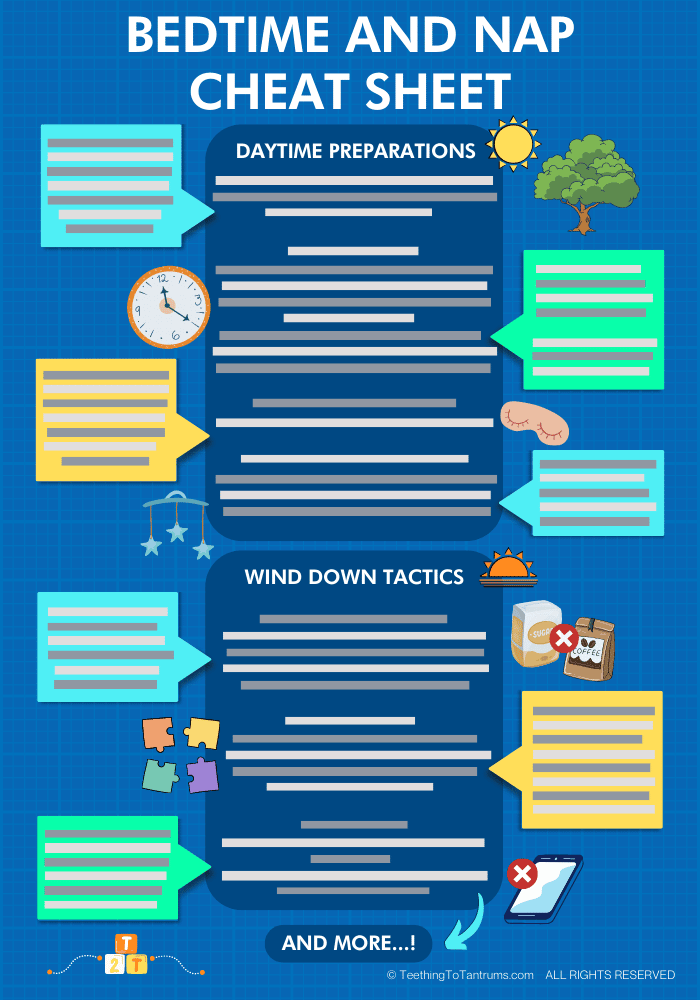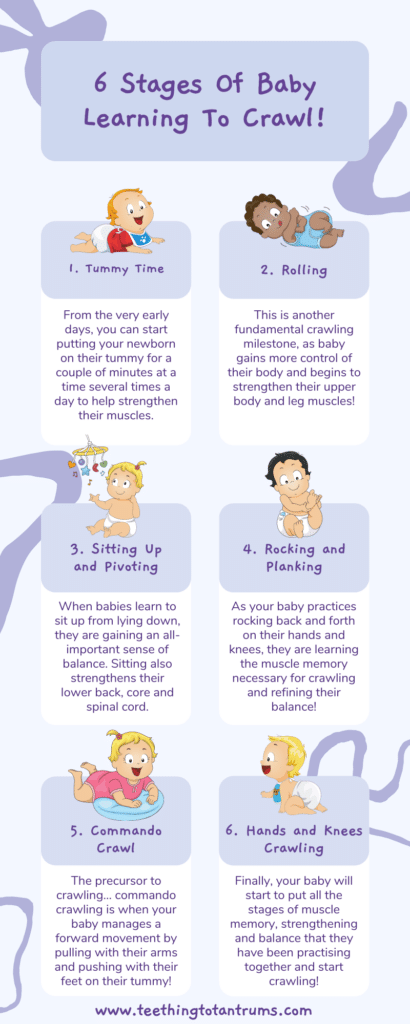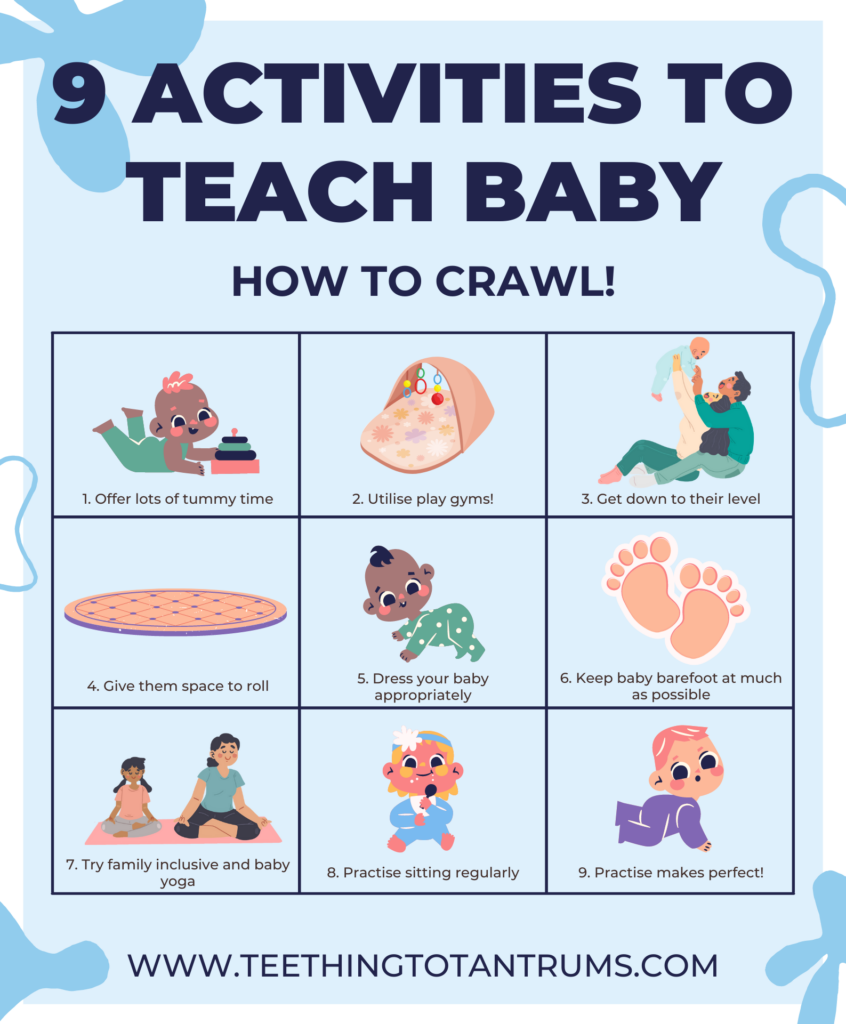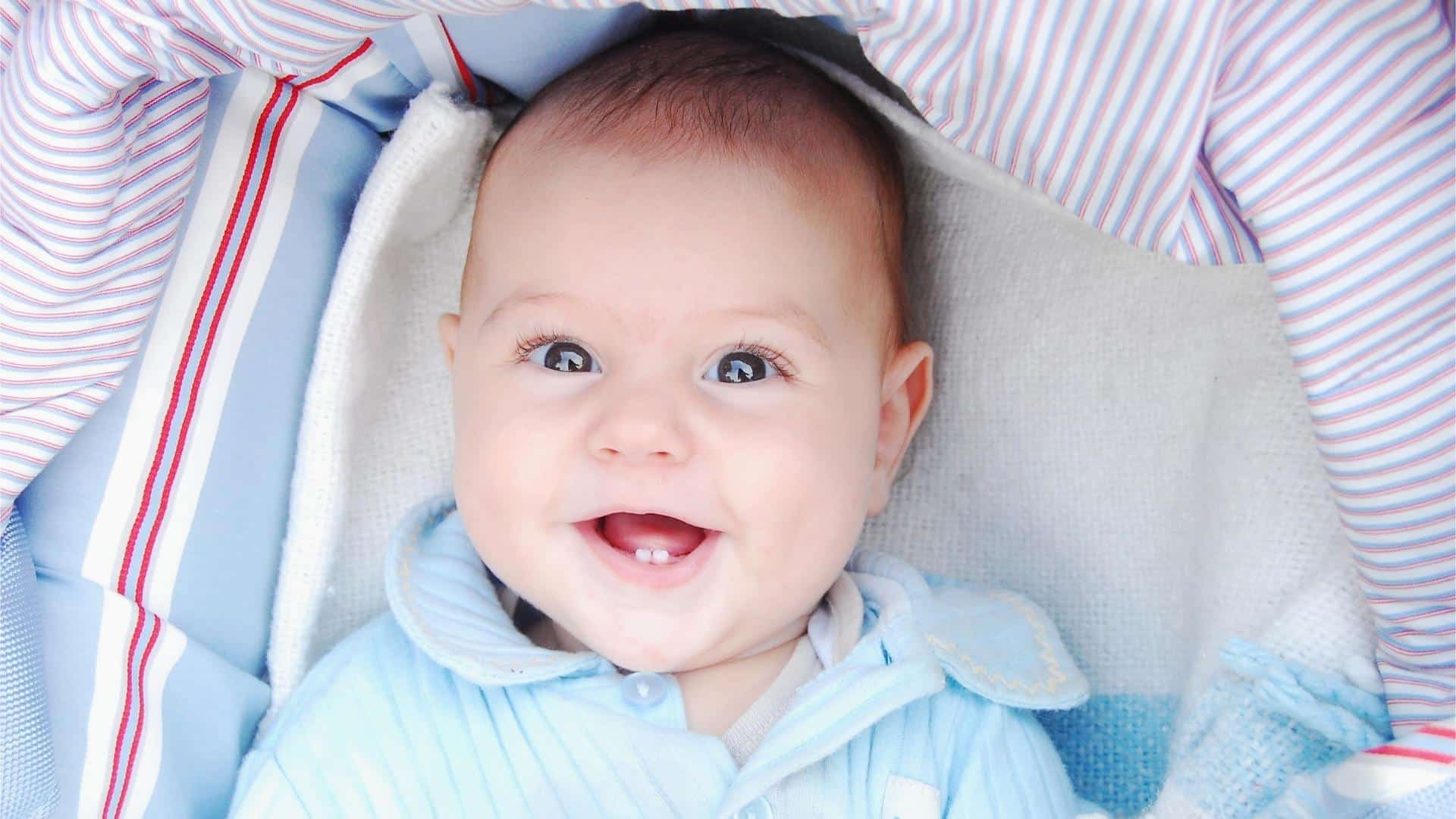Crawling is a major milestone that signifies the start of your baby’s future mobility. Read on to learn when do babies start crawling, what different crawling styles there are, how to encourage healthy physical development and what to do if your baby doesn’t crawl as expected.
When Do Babies Start Crawling?
Your baby should start crawling in some form between 7 and 10 months of age. It is important to not compare your baby to others who are mobile already as all babies develop at their own pace and your child will crawl when they’re ready.
What Is A Crawl?
When we visualise a baby crawling we usually imagine the classic hand and knees crawl. But the definition of a crawl is simply: the phase of movement before your baby learns to walk.
And there are many ways in which babies can crawl too…
The 5 Methods Of Crawling
There are several different methods of crawling and your little one may opt for one or a mixture of the following:
- Hands and knees crawl. This is the classic crawl we all think of when someone mentions a crawling baby. In this technique, your baby will move along using the palms of their hands as they shuffle along on their knees, shins and tops of their feet.
- Bear crawl. This crawling method is when your baby has straight limbs and their knees are off the ground. They then hold this bear-like pose as they move.
- Crab crawl. In this technique, your baby will crawl backwards and sideways propelling themselves with their hands.
- Bottom shuffle. The bottom shuffle is another common crawl. Babies will use their arms to move themselves forward while they stay sitting on their bottom.
- Commando crawl (also known as the army crawl). The commando crawl is when your baby pulls themselves along the floor military-style using their arms and pushing with their feet but keeping their belly prone to the floor. This is often the pre-runner to the conventional crawl on hands and knees.
Crawling And Sleep Disruption
Sleep disruptions usually occur when baby goes through a big developmental leap and it’s very common to experience sleep challenges when your baby begins to learn to crawl.
Your baby may find it more exciting to practice in their crib as opposed to closing their eyes and going to sleep. This can be a big trigger for a sleep regression around 8 or 9 months.
For more information about how to navigate the 8-month sleep regression, check out this post.
Looking to get your little one to sleep quickly and effortlessly? Check out my Bedtime and Nap Cheat Sheet and master the art of making daytime naps and bedtimes as seamless as possible.
A bedtime & nap cheat sheet so good your little one will ask you to put them to bed...
Laura Williams "This is a life saver! I'm so glad I downloaded your bedtime & nap cheat sheet. My little one actually asked me to put him to bed last night! Unbelievable! Thank you so much!"
Click Here For The FREE Cheat Sheet
What Are The 6 Stages Of Learning To Crawl?
So how does your baby learn to crawl?
Well, first they have to develop strong upper body and neck muscles then they have to work on balance and coordination… and then, most importantly, they have to practice.
Here are the 6 stages of baby crawling:

1. Tummy Time
From the very early days, you can start putting your newborn on their tummy for a couple of minutes at a time as part of your daily routine. Gradually increase the amount of tummy time your baby is having and make their time more interesting by providing tummy time toys, books and activity mats.
NOTE: If your baby is struggling with tummy time, read my tummy time post to learn more.
2. Rolling
Between 4 and 6 months, your baby will start to roll over during tummy time. They will normally roll from front to back and then back to front.
This is another fundamental baby development milestone towards crawling, as they gain more control of their body and strengthen their arm and leg muscles, as well as their neck and shoulder muscles.
TOP TIP: Some babies use rolling for a long time to get to where they want to go and they can become very good at getting across the room by using this method!
3. Sitting Up And Pivoting
When babies learn to sit up from lying down, they are gaining an all-important sense of balance.
Being in a seated position also strengthens their lower back, core and spinal cord. Together all of these things are necessary for them to develop the motor skills, strength, control and stamina in their arms and legs required for crawling.
During this phase, you may also notice that your baby starts to pivot and swivel whilst on their tummy.
4. Rocking And Planking
Next comes rocking and planking.
As your baby practices rocking back and forth on their hands and knees or pushing themselves into a plank position, they are learning the muscle memory necessary for crawling and refining their balance in the crawling position. These are all tell-tale signs baby is getting ready to crawl.
5. Commando Crawl
The commando crawl is the last stage before proper crawling that your baby will go through.
As I mentioned above, this is when your baby actually manages a forward movement in the form of a belly crawl, pulling with their arms and pushing with their feet.
6. Hands And Knees (maybe)
Finally, your baby will start to put all the stages of muscle memory, strengthening and balance that they have been practising together and start crawling on their hand and knees.
Here’s a beautiful video to help you visualise the stages your baby will go through when learning to crawl.
TOP TIP: Remember that not all babies will crawl in the conventional hands and knees way… But whichever method they choose your little one will have been working up to this moment from birth.
How To Teach Baby To Crawl
There are so many things you can do to help motivate and encourage your baby to learn how to crawl. Here are my top 9 tricks to try:

1. Offer Lots Of Tummy Time
It goes without saying that ensuring your baby has age-appropriate tummy time is the best way to start them on the road to crawling.
Offering lots of floor time and physical activity opportunities will all go a long way to helping your baby with tummy time and movement milestones.
2. Utilise Play Gyms
Play gyms allow your baby to practice their reaching up, grabbing and swiping actions with objects while lying on their backs. All of these actions are ideal for strengthening the upper body and arm muscles in preparation for crawling.
This play gym is designed by experts for baby's developing brain and body. Winner of multiple awards it includes everything you need in an activity gym-from batting to teething to learning to focus-for a whole year of play.
3. Get Down To Their Level
If your baby is struggling to enjoy tummy time or playing on their own get down to their level and talk and chat with them. You are their favourite plaything in the early days and having you down there with them will give them focus and encouragement.
4. Give Them Space To Roll
Give your baby plenty of space in a safe place to reach and roll. Rolling is a great exercise for your pre-crawler and a play mat is a wonderfully soft and entertaining place for your trainee crawler to practice their skills.
5. Dress Your Baby Appropriately
Make sure your baby is dressed in loose-fitting comfy clothing that allows them to move unrestricted.
Some babies don’t like the feel of certain surfaces on their bare skin and will prefer to have their legs covered as they move closer to crawling, while others don’t mind at all.
Dungarees and coveralls are ideal for your baby once they are moving more.
6. Stay Barefoot
When learning to crawl, being barefoot allows your baby to better feel the surfaces beneath them when they push up in the plank position or propel themselves across the floor in a belly crawl.
Being barefoot also strengthens the feet, ankle and leg muscles and movements required for learning to walk down the line.
If your baby has to wear shoes to stay safe when out and about, opt to wear barefoot shoes, leather or super flexible baby shoes to offer protection whilst still allowing your little one’s feet to move and flex as naturally as possible. Like these Clamfeet Organic Cotton Vegan Baby Shoes:
7. Baby Yoga
If your baby is not keen on tummy time, baby yoga exercises are a great complementary way for them to develop those all-important upper body muscles whilst being lots of fun for both you and baby/.
8. Practice Sitting
Sitting teaches balance and allows your baby to learn how to lean forward and sideways while supporting themselves with their arms and then pushing back up to sitting.
Give your baby plenty of opportunities to play with toys while sitting and help them to gain balance by putting toys where they have to lean and reach for them, with you at hand to catch them if they lose their balance.
9. Practice Makes Perfect
Playing simple games with your baby as they start to crawl will help them achieve the developmental goals necessary to become expert crawlers.
- Place toys just out of reach to motivate your baby to move.
- Roll a ball towards and away from your baby and encourage them to reach and crawl after it.
- Put your baby on different textures and let them experience how it feels to roll around on it.
- Allow baby to squirm and crawl on play mats, bubble wrap or different fabrics to understand that the world isn’t all hard floor and carpet.
- Create a mini obstacle course with pillows, sofa cushions and small boxes for your crawler to navigate around.
- Get down to their level and make eye contact when crawling with them to encourage them towards you.
What To Avoid When Teaching Baby To Crawl
Giving your baby as many opportunities to use their bodies to finally be able to crawl is vital but there are certain things that should be avoided as they may inhibit your little one’s crawling development.
Things to limit or avoid when baby is learning to crawl include:
- Putting baby in bouncers and walkers
- Spending excessive time in baby carriers
- Carrying your baby around too much
- Keeping your baby in reclining baby chairs for too long
- Restrictive clothing
Of course, one slightly tight jumper for a special occasion or a few minutes in a bouncer will not harm your baby… But by being aware that extended exposure to these behaviours may cause baby some crawling inhibitions, you will be ensuring baby gets the most out of every day.
Baby Proof Your Home For A Crawling Baby
Babyproofing your home in preparation for a crawling baby is also hugely important. As soon as you think your baby’s mobility is around the corner you should do the following:
- Cover all electrical sockets with safety covers
- Eliminate all hanging electrical leads, tablecloths, blinds and curtain cords
- Secure all wobbly furniture
- Cover sharp corners with rubber protectors
- Put child locks on drawers and cupboards
- Install stair baby gates
- Lift all pet bowls from the floor
- Remove all pot plants from the floor
Your baby will become mobile a lot quicker than you think and it’s only a matter of time until they’re pulling up on the edge of a coffee table and reaching for everything they can get their hands on.
So if you get the feeling that they may start moving soon, it’s better to be safe than sorry and get your home babyproofed.
TOP TIP: To find all the potential hazards for a crawling baby… Get down on the floor and look at each room from your crawling baby’s perspective to ensure that you have not missed any!
Should You Be Concerned If Baby Is Not Crawling?
As we are always saying, all babies reach developmental milestones at different times.
Some babies may skip conventional crawling altogether and go from bottom shuffling to pulling to standing and taking their first steps without a backwards glance.
You should also consider that your baby may not be moving towards crawling because they have not been given enough opportunity to practice…
However, if you feel that despite you offering all the necessary opportunities for them to learn to crawl and they are not developing as expected, then you should seek medical advice from a health professional or pediatrician.
What To Also Look For If Baby Is Not Crawling
If your baby is not crawling and it’s accompanied by these signs, you should definitely visit a childhood development specialist to rule out any developmental delays or underlying conditions:
- Your little one is not kicking and moving their legs
- Your baby is not trying to reach out or wriggle towards objects
- Baby does not wriggle or become physically animated when you go to pick them up
- Your baby is not using their legs to support themselves when held by 6 months of age.
Need More Parenting Help?
- Download our FREE Bedtime & Nap Sleep Cheat Sheet. It’s a free, easy-to-use and proven formula designed for parents of 0-5 year olds to master the art of consistently undisturbed and restful sleep without the yelling, nagging or exhausting long-winded evenings.
- Check out our Parenting Toolbox. You’ll get access to expertly-chosen products that you can guarantee are the best for your little one and your wallet.
- Are you looking for personalized guidance to navigate the challenges of parenting? I offer 1-on-1 consultations to bring you tailored strategies and actionable advice to help support your child's growth and well-being with confidence.

A bedtime & nap cheat sheet so good your little one will ask you to put them to bed...
Laura Williams "This is a life saver! I'm so glad I downloaded your bedtime & nap cheat sheet. My little one actually asked me to put him to bed last night! Unbelievable! Thank you so much!"
Click Here For The FREE Cheat Sheet





